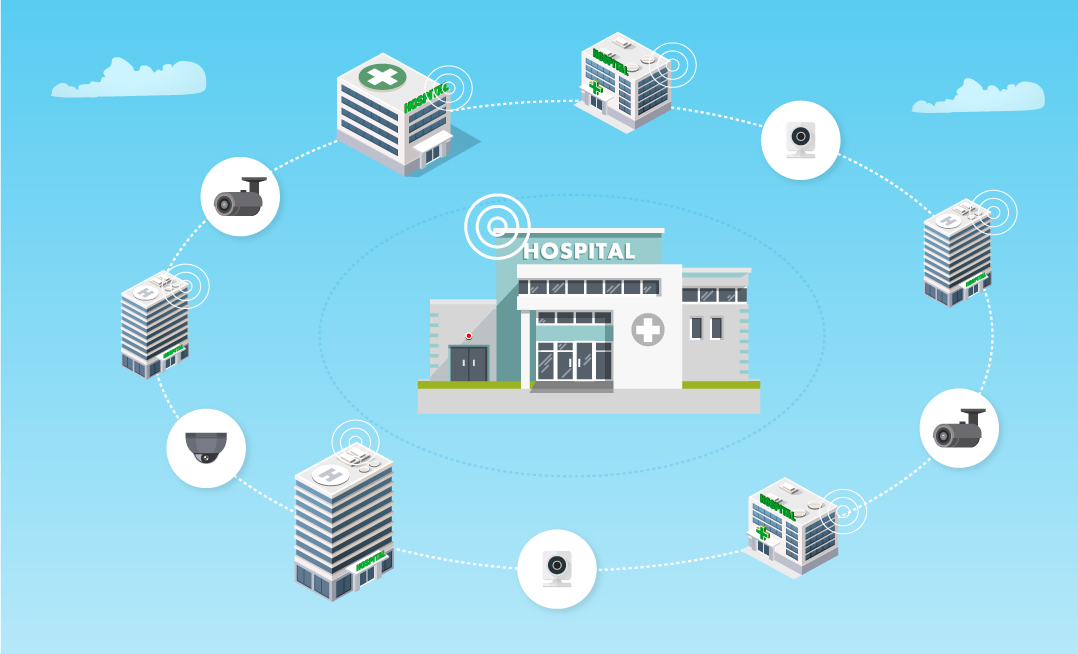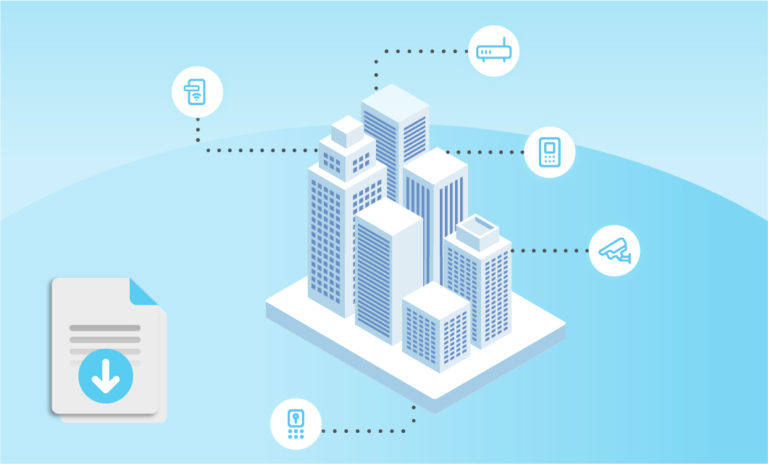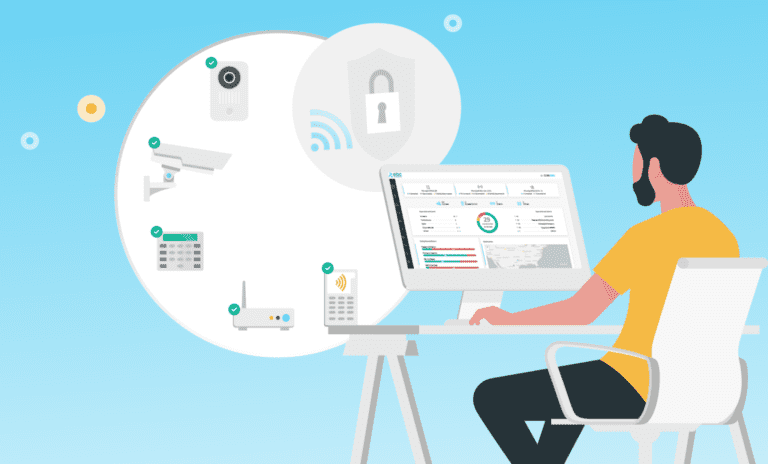
Streamlining costs while improving operational management and visibility will always be priorities for the healthcare sector. Organizations need to find innovative ways of protecting patients, visitors, and medical professionals without losing their focus on the end goal – health. Creating efficient, inexpensive, and reliable automated and intelligent systems has become a critical touchpoint for healthcare success and long-term growth and sustainability.
The path toward realizing your IoT physical security investment
Healthcare systems with multiple medical centers have already taken bold steps down the road towards Internet of Things (IoT) functionality, with impressive investments in physical security devices to protect people that enter their facilities, as well as medical resources inside. This is achieved by using a wide range of physical security devices, such as video surveillance cameras, access control, intercoms and more. However, without centralized or automated management of these networked devices, they cannot ensure security, operational efficiency, and reduced risk of vulnerabilities.
With no real-time visibility into the status of any given device, if a device goes offline, there is the risk that it will go unnoticed and open unexpected vulnerabilities in the security system. Conducting routine device maintenance manually to avoid the risks is expensive and time-consuming, especially since it also involves password rotations, firmware upgrades, and device restarts. Effective management of physical security in healthcare is crucial to mitigate these risks.
Organizations need an effective management system with tools to ensure that the devices are fully operational at all times, that there is visibility into the status of each device from a central dashboard in real time, and that operational activities can be handled quickly and automatically.
The intelligent resolution for physical security in healthcare
SecuriThings Enterprise transforms the operational management of physical security devices, changing an organization’s security posture and system functionality. The solution monitors all IoT security devices throughout the organization’s ecosystem, ensuring that they stay online and operate optimally. In the event of device failure or an issue, SecuriThings automatically alerts the relevant security professionals in real time, enabling them to rapidly diagnose and resolve the problem and providing the tools they need to resolve most issues remotely. The platform completely bypasses the risk of missing a potential issue until it is too late.
SecuriThings also provides medical centers with the tools to automate routine maintenance, increasing their cybersecurity posture. SecuriThings finds security and operational risks that need immediate attention, alerting the relevant teams to remediate these vulnerabilities and helps organizations achieve measurable cost savings by reducing reliance on expensive, manual, on-site work.
SecuriThings Enterprise helps improve operational management by ensuring that physical security devices comply with internal policies. Automated routine maintenance aligns with the medical facility’s specifications, reducing the risks of human error and cybersecurity vulnerabilities. This alignment is key to ensuring robust physical security in healthcare environments.
Configurable and detailed compliance reports ensure that security professionals are kept up to date with comprehensive visibility into thousands of devices at all times. SecuriThings provides a highly agile, transparent, and robust wealth of insights that transforms the healthcare system’s operations.
Smart resolution
Read this case study to learn how SecuriThings Enterprise moved the overall performance, capability, and security of one healthcare system’s IoT operational management up several smart notches. With improved system availability, significant cost savings, robust protection from cyberthreats, and trusted compliance, SecuriThings helped the healthcare system achieve its mandates and ensure ongoing security for its people and operational infrastructure.
FAQs
What is physical security in healthcare?
Physical security in healthcare refers to the comprehensive set of measures and systems implemented to protect patients, staff, visitors, and medical resources within healthcare facilities. This includes the use of video surveillance cameras to monitor activity, access control systems to restrict entry to authorized personnel, intercoms for secure communication, and other security devices designed to create a safe and secure environment. The goal of physical security in healthcare is to prevent unauthorized access, protect sensitive information, and ensure the safety and well-being of everyone within the facility.
Why is physical security in healthcare important?
Physical security in healthcare is critically important because it safeguards not only the physical safety of patients and staff but also the integrity of sensitive medical data and resources. Healthcare facilities often house valuable equipment and medications that need to be protected from theft and tampering. Additionally, they handle confidential patient information that must be secured to comply with privacy regulations. Effective physical security measures help prevent unauthorized access to restricted areas, reduce the risk of violence or theft, and ensure a secure and trusted environment where medical professionals can focus on providing quality care.
How can IoT improve physical security in healthcare?
The Internet of Things (IoT) can significantly enhance physical security in healthcare by enabling real-time monitoring, management, and automation of security devices across a facility. IoT solutions provide a centralized platform where security professionals can monitor the status of all connected devices, such as cameras, access control systems, and sensors, from a single dashboard. This centralized approach allows for immediate detection and response to any issues, such as device malfunctions or security breaches. Additionally, IoT can automate routine maintenance tasks like firmware updates, password rotations, and device health checks, ensuring that security systems are always functioning optimally and reducing the risk of vulnerabilities.
What are the challenges of implementing physical security in healthcare?
Implementing physical security in healthcare comes with several challenges. One major challenge is the need for continuous and comprehensive monitoring of all security devices to ensure they are operational and secure. Regular maintenance, including updates and repairs, can be resource-intensive and time-consuming. Another challenge is integrating various security systems and devices, which often come from different manufacturers and may not be designed to work together seamlessly. Ensuring compliance with healthcare regulations, such as HIPAA in the United States, adds another layer of complexity, as facilities must protect patient data and privacy while maintaining physical security. Additionally, healthcare facilities must address cybersecurity threats that could compromise their physical security systems.
What are the benefits of a robust physical security system in healthcare?
A robust physical security system in healthcare offers numerous benefits. Firstly, it enhances the protection of patients, staff, and visitors by preventing unauthorized access and reducing the risk of violence or theft. Secondly, it safeguards sensitive medical data and resources, ensuring compliance with privacy regulations and maintaining the integrity of healthcare operations. Thirdly, a well-implemented security system can lead to significant cost savings by reducing the need for manual maintenance and on-site security personnel. Automated monitoring and management systems can quickly identify and resolve issues, minimizing downtime and enhancing overall operational efficiency. Finally, a strong physical security system builds trust and confidence among patients and staff, creating a safer and more secure healthcare environment.




